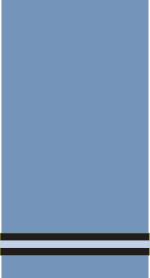Flying officer

Flying officer (Fg Off in the RAF and IAF; FLGOFF in the RAAF; FGOFF in the RNZAF; formerly F/O in all services and still frequently in the RAF) is a junior commissioned rank in the Royal Air Force[1] and the air forces of many countries which have historical British influence. It is also sometimes used as the English translation of an equivalent rank in countries which have a non-English air force-specific rank structure. In these cases a Flying Officer usually ranks above pilot officer and immediately below flight lieutenant.
It has a NATO ranking code of OF-1 and is equivalent to a lieutenant in the British Army or the Royal Marines. However, it is superior to the nearest equivalent rank of sub-lieutenant in the Royal Navy.[2]
The equivalent rank in the Women's Auxiliary Air Force was "section officer".
Origins
The term "flying officer" was originally used in the Royal Flying Corps as a flying appointment for junior officers, not a rank.
On 1 April 1918, the newly created RAF adopted its officer rank titles from the British Army, with Royal Naval Air Service sub-lieutenants (entitled flight sub-lieutenants) and Royal Flying Corps lieutenants becoming lieutenants in the RAF. However, with the creation of the RAF's own rank structure on 1 August 1919, RAF lieutenants were re-titled flying officers, a rank which has been in continuous use ever since.
Usage
The rank title does not imply that an officer in the rank of flying officer flies. Some flying officers are aircrew, but many are ground branch officers. Amongst the ground branches some flying officers have command of flights.
In the RAF, aircrew and engineer officers are commissioned directly into the rank of flying officer, while ground branches are commissioned as pilot officers for an initial period of six months. Time served in the rank of flying officer varies depending on branch before automatic promotion to flight lieutenant; aircrew and BEng qualified officers will serve for a period of 2½ years, MEng qualified engineers for 1½ years, and all other ground branches for 3½ years. A graduate entrant who has an MEng but is joining a ground branch other than engineer will serve 3½ years as a flying officer – the early promotion for MEng engineers is designed as a recruitment incentive. The starting salary for a flying officer is £30,616.80 per year.[3]
In many cases the rank of flying officer is the first rank an air force officer holds after successful completion of his professional training. A flying officer might serve as a pilot in training, an adjutant, a security officer or an administrative officer and is typically given charge of personnel and/or resources. By the time aviators have completed their training, they will have served their 2½ years and typically join their frontline squadrons as flight lieutenants.
Insignia
The rank insignia consists of one narrow blue band on slightly wider black band. This is worn on both the lower sleeves of the tunic or on the shoulders of the flying suit or the casual uniform. The rank insignia on the mess uniform is similar to the naval pattern, being one band of gold running around each cuff but without the Royal Navy's loop.
 An RAF flying officer's sleeve/shoulder insignia
An RAF flying officer's sleeve/shoulder insignia An RAF flying officer's sleeve mess insignia
An RAF flying officer's sleeve mess insignia An RAF flying officer's sleeve on No.1 best dress uniform
An RAF flying officer's sleeve on No.1 best dress uniform
Other air forces
The rank of flying officer is also used in a number of the air forces in the Commonwealth, including the Bangladesh Air Force, Indian Air Force (IAF), Pakistan Air Force (PAF), Royal Australian Air Force (RAAF) and Royal New Zealand Air Force (RNZAF).
The Royal Canadian Air Force (RCAF) used the rank until unification of the three armed services into the Canadian Forces in 1968 and army-type ranks were adopted. RCAF personnel holding this rank then switched to the rank of lieutenant. In official French Canadian usage, a flying officer's rank title was lieutenant d'aviation.[4] Although the RCAF again became a named organization in the Canadian Forces in 2011, the RCAF continued to retain army-type ranks.
The rank of "warrant flying officer" was also used by the air service of the Imperial Japanese military.
This rank is an equivalent for lieutenant in the Royal Malaysian Air Force
See also
References
- ↑ "Ranks and Badges of the Royal Air Force". Royal Air Force. 2011. Archived from the original on 9 July 2011. Retrieved 21 April 2011.
- ↑ "Armed Forces Act 2001". www.legislation.gov.uk. Archived from the original on 9 January 2013.
- ↑ "Rates of Pay, 2015" (PDF). raf.mod.uk. Archived (PDF) from the original on 21 September 2015. Retrieved 1 April 2016.
- ↑ http://www.castlearchdale.net/id37.html%5Bpermanent+dead+link%5D
| NATO rank code | Student officer | OF-1 | OF-2 | OF-3 | OF-4 | OF-5 | OF-6 * |
OF-7 ** |
OF-8 *** |
OF-9 **** |
OF-10 ***** | ||
|---|---|---|---|---|---|---|---|---|---|---|---|---|---|
| Royal Navy | O Cdt | Mid | SLt | Lt | Lt Cdr | Cdr | Capt | Cdre | RAdm (list) |
VAdm (list) |
Adm (list) |
Adm of the Fleet | |
| Royal Marines | O Cdt | 2Lt | Lt | Capt | Maj | Lt Col | Col | Brig | Maj-Gen | Lt-Gen | Gen (list) |
Capt-Gen | |
| Army | O Cdt | 2Lt | Lt | Capt | Maj | Lt Col | Col | Brig | Maj-Gen (list) |
Lt-Gen (list) |
Gen (list) |
Fd Mshl | |
| Royal Air Force | Off Cdt / SO | APO / Plt Off | Fg Off | Flt Lt | Sqn Ldr | Wg Cdr | Gp Capt | Air Cdre | AVM | Air Mshl | Air Chf Mshl (list) |
Mshl of the RAF | |



